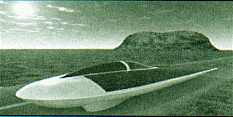
SPAIN
BLOCKS OF ICE FALL FROM THE SKIES
Only nine were real and the rest were fake
 For two weeks in January there were reports
from all over Spam of strange blocks of ice crashing down* and destroying cars
and parts of buildings. From Andalucia to Asturias the police were called out
to investigate reported impacts and the remains of the projectiles were carried
off* to the nearest laboratories for analysis. Newspapers and T.V. news
programmes all had special reports from the different 'impact areas' and the
talk in bars and public squares was dominated by the possibilities of meteor
storms or aeroplanes emptying their lavatories over our heads. For two weeks in January there were reports
from all over Spam of strange blocks of ice crashing down* and destroying cars
and parts of buildings. From Andalucia to Asturias the police were called out
to investigate reported impacts and the remains of the projectiles were carried
off* to the nearest laboratories for analysis. Newspapers and T.V. news
programmes all had special reports from the different 'impact areas' and the
talk in bars and public squares was dominated by the possibilities of meteor
storms or aeroplanes emptying their lavatories over our heads. As the investigations progressed it became apparent that the phenomena was less worrying than at first thought as the majority of the blocks analysed were proved to be home made fakes. People were trying to cash in* on what had become the latest talking point and someone, obviously with too much time on his or her hands, had even set up* a web site with instructions on how to make your own ice |
blocks, You could even buy them made to order for a few thousand pesetas. In the end just nine were classified as real 'falls' and the rest were marked as 'found' Theories describing the blocks as parts of a meteorite or as contents of aeroplane toilets were soon dismissed as it became clear that the blocks were made up of natural water and didn't contain any bodily waste or anything extraterrestrial. Later in the month similar objects were reported in Italy and during the investigations in Spain a Brazilian scientist contacted the research team. Apparently he had studied two similar objects that had fallen over Brazil and hadn't reached any conclusions about their origin- It seems that the scientists are not totally sure about the origin of the objects but most believe that they are formed naturally in the stratosphere. Yet another reason to wear a helmet when we go out on our bikes' |
|||
| |
|
RACE TO THE SUNCatalans students build a solar powered car for Australian race |
A solar powered car built by students from Catalunya Polytechnic
University and the Autonomous University of Barcelona will compete in this
year's SunRace. The event takes place in Australia from the 11th to the 20th of February. In total some fifty vehicles will participate in the race from Sydney to Melbourne - via the capital Canberra, through the outback* and visiting various cities - a distance of 1,790 kilometres. This is the first time a team from Catalunya has entered the race. Their car is named 'Despertaferro.' It has three wheels, is one metre high, its 'nose' is two metres wide and its tail is six metres long |
 . The vehicle is made of carbon fibre, and the tail part is covered with solar panels. It weighs just 220 kilos and is capable of reaching 105 kilometres per hour (65 mph). The race is in its fourth year, and its main objective is to foster the use of renewable energy and promote the development and use of practical everyday electrical vehicles |
|
| GuggenheimClicks | Air Tickets| Buy Music | Downloads | Children| Free Games | Yellow Pages | |
| Headlines | Electronics | Buy Videos| Weather| Buy books | Toy and Stuff.. | ||
Copyright © 1999 Amazing Stuff & Co. v